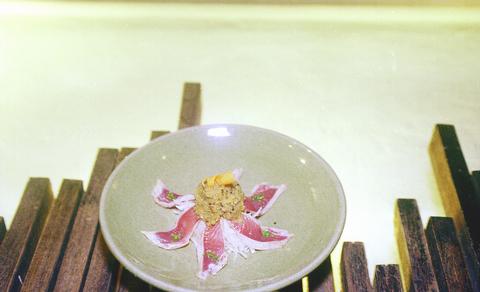Located in an alley off Anho Rd, Mu-Lan has a facade that's more of a garage than a Japanese restaurant. Only after you slide open its heavy iron gate, hear the acid jazz in the air, see the modern interior design and hear the waiters' uniformed and high-spirited "welcome" would you realize this is one of Anho circle's more up-market establishments.
Extensively covered in the Chinese-language media for its exquisite cuisine as well as being a popular celebrity hangout, Mu-Lan attracts a full house of gourmet customers on the weekdays, not to mention the waiting lines outside on the weekend.
Although the dishes here are by no means cheap, it's a nice place to have a nice dinner in the laid-back atmosphere of its dimly lit private booths. The menu comes in two kinds, one seasonal and one daily menu, which its Japanese chef writes down everyday depending on what he picked up at the market.

PHOTO: DAVID VAN DER VEEN, TAIPEI TIMES
The restaurant is best at what it calls "creative Japanese cuisine," a new cooking style which prepares indigenous Japanese ingredients in ways inspired by French, Italian, Korean and other traditions.
Tuna Tataki (NT$450) literally means half-baked tuna. This pretty dish comes with six slices of tuna on a carpet of sauce with a block of orange colored sauce on top of the fish. The sashimi is then stirred with the sauces before being eaten. The sauces are made of onion, garlic, vinegar, apple and mixed sesame, giving the dish an interesting taste without overpowering the fish flavor.
Sirloin beef with fruit sauce (NT$520), is as attractive as it is delicious. The slices of beef are casually laid out on the plate. The mixed fruit sauce with vinegar brings out the succulence of the beef.
The grilled chicken (NT$450) tastes more like French than Japanese cuisine. First grilled and then briefly sauteed, the fragrant chicken slices have both a crispy skin and tender meat. The creamy sauce in which the chicken and the accompanying mushroom and carrot are dipped has the full taste of butter without cloying your taste buds.
Among Mu-Lan's innovative drinks are a dozen kinds of sake cocktails designed for light drinkers. Vegetarian (NT$280) and Slam (NT$250) are the two most popular kinds with carrots and celery as their main ingredients.
Mu-Lan sake (NT$1,300 or NT$2,500, depending on size) is a quality drink with a smooth taste. To go either with it or the other alcoholic drinks the restaurant offers, you may want to have cod fish egg cheese (NT$250). The lightly spicy eggs are blended with cheese cubes and spread on vegetable leaves.
For budget-conscious gourmets, Mu-Lan also provides four kinds of lunch sets (NT$320 to NT$380). They have proven quite popular with office workers in the neighborhood.

In the March 9 edition of the Taipei Times a piece by Ninon Godefroy ran with the headine “The quiet, gentle rhythm of Taiwan.” It started with the line “Taiwan is a small, humble place. There is no Eiffel Tower, no pyramids — no singular attraction that draws the world’s attention.” I laughed out loud at that. This was out of no disrespect for the author or the piece, which made some interesting analogies and good points about how both Din Tai Fung’s and Taiwan Semiconductor Manufacturing Co’s (TSMC, 台積電) meticulous attention to detail and quality are not quite up to

April 21 to April 27 Hsieh Er’s (謝娥) political fortunes were rising fast after she got out of jail and joined the Chinese Nationalist Party (KMT) in December 1945. Not only did she hold key positions in various committees, she was elected the only woman on the Taipei City Council and headed to Nanjing in 1946 as the sole Taiwanese female representative to the National Constituent Assembly. With the support of first lady Soong May-ling (宋美齡), she started the Taipei Women’s Association and Taiwan Provincial Women’s Association, where she

Chinese Nationalist Party (KMT) Chairman Eric Chu (朱立倫) hatched a bold plan to charge forward and seize the initiative when he held a protest in front of the Taipei City Prosecutors’ Office. Though risky, because illegal, its success would help tackle at least six problems facing both himself and the KMT. What he did not see coming was Taipei Mayor Chiang Wan-an (將萬安) tripping him up out of the gate. In spite of Chu being the most consequential and successful KMT chairman since the early 2010s — arguably saving the party from financial ruin and restoring its electoral viability —

It is one of the more remarkable facts of Taiwan history that it was never occupied or claimed by any of the numerous kingdoms of southern China — Han or otherwise — that lay just across the water from it. None of their brilliant ministers ever discovered that Taiwan was a “core interest” of the state whose annexation was “inevitable.” As Paul Kua notes in an excellent monograph laying out how the Portuguese gave Taiwan the name “Formosa,” the first Europeans to express an interest in occupying Taiwan were the Spanish. Tonio Andrade in his seminal work, How Taiwan Became Chinese,